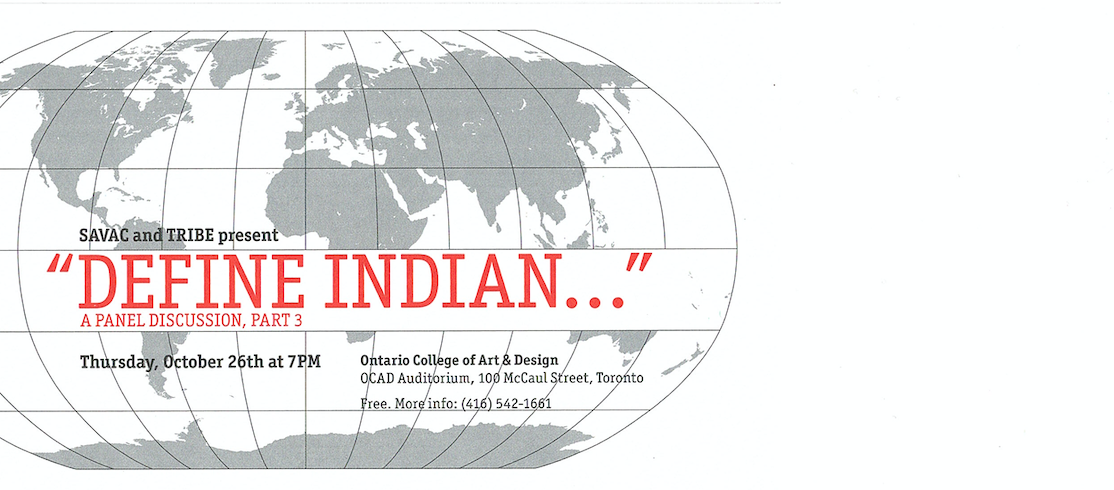
Define Indian — Shooting Indians: A journey with Jeffrey Thomas
by Ali Kazimi
Co-Production with Paved Arts and TRIBE Inc.
Shooting Indians examines cross-cultural experiences between Aboriginal and Indian artists. Shot over a period of nine years, the film breaks new ground in offering a dialogue between photographer Jeffrey Thomas, and filmmaker Ali Kazimi.
At one level, Shooting Indians is a portrait of Jeffrey Thomas, an Iroquois photographer. The film explores the influences on his life that led him to his career. It was the work of an American photographer from the turn of the century, Edward Curtis, which forced Thomas to closely examine how Native people had been photographed in the past. Thomas views Curtis’ monumental work as a “mountain which must be crossed.”
On another level is the irony of an Indian from India making a film on a North American Indian and this is woven throughout the fabric of the film. Then there is Curtis, the enigmatic photographer who crisscrossed the North American West for thirty years documenting Native people at the turn of the century. Curtis’s romantic images have seduced many viewers including the filmmaker, for whom these images are reminiscent of the Hollywood Westerns he grew up with in India. In a surprising turn of events, the paths of Kazimi, Thomas and Curtis intersect on Vancouver Island and from this complex juxtaposition of part and present, the filmmaker and his subject, the photographer and his art, emerges not only a portrait of a talented photographer but a film that goes beyond stereotypes.
As in any journey, it is not the destination but the movement and its attendant unpredictability that reveals much about its attendant unpredictability that reveals much about the subject the filmmaker and the people they meet along the way. In the end Kazimi concludes: “The vanishing race has emerged from the shadows reborn, renewed and asserting its cultural survival. Aboriginal cultures, like all cultures including my own, have borrowed, incorporated and absorbed influences from all encounters, absorbing, reviving and at times reinventing themselves. In the end what has vanished is my image of the authentic, imaginary, Red Indian.”
Screening: 9 November 2005, 7pm
Ongoing viewing: 15 November 2005 — 3 December 2005
This screening is presented in conjunction with Define Indian, a panel discussion co-organized by TRIBE iNC., and SAVAC (South Asian Visual Arts Collective). The panel discussion will take place on Thursday Nov. 10 at 6 pm at the Gordon Snelgrove Gallery, University of Saskatchewan.
Filmmaker Ali Kazimi was born and raised in India. He moved to Canada in 1983, earning his BFA in Film Production from York University. Based in Toronto, Ali is an internationally acclaimed documentary filmmaker. He has worked as producer, director, writer and cinematographer on numerous productions including the globally celebrated Narmada: A Valley Rises (1994) and the Gemini-nominated Continuous Journey (2004). In addition to his creative roles, Ali has taught film and video and played an important role in organizations that support independent filmmaking. Shooting Indians – A Journey with Jeffrey Thomas is the recipient of numerous awards, including the Certificate of Merit- Golden Gate Awards, San Francisco International Film Festival, 1996, Finalist – Best Short Documentary Genie Award (Canadian Academy Award), 1997; and Finalist – Best Arts Documentary, HOT DOCS! Canadian National Documentary Awards, 1998.
Photographer Jeffrey Thomas was born in Buffalo, N.Y., and now lives in Ottawa. He is a member of the Onondaga nation, part of the Six Nations Confederacy. Issues of First Nations identity and representation are central to his curatorial as well as artistic practice. His photographs have been collected and exhibited by numerous institutions in Canada and the United States and he has researched and curated photographic exhibitions for the National Archives of Canada, including Where Are the Children? Healing the Legacy of the Residential Schools. In 1998, Jeffrey Thomas was awarded the Canada Council’s prestigious Duke and Duchess of York Photography Award.






